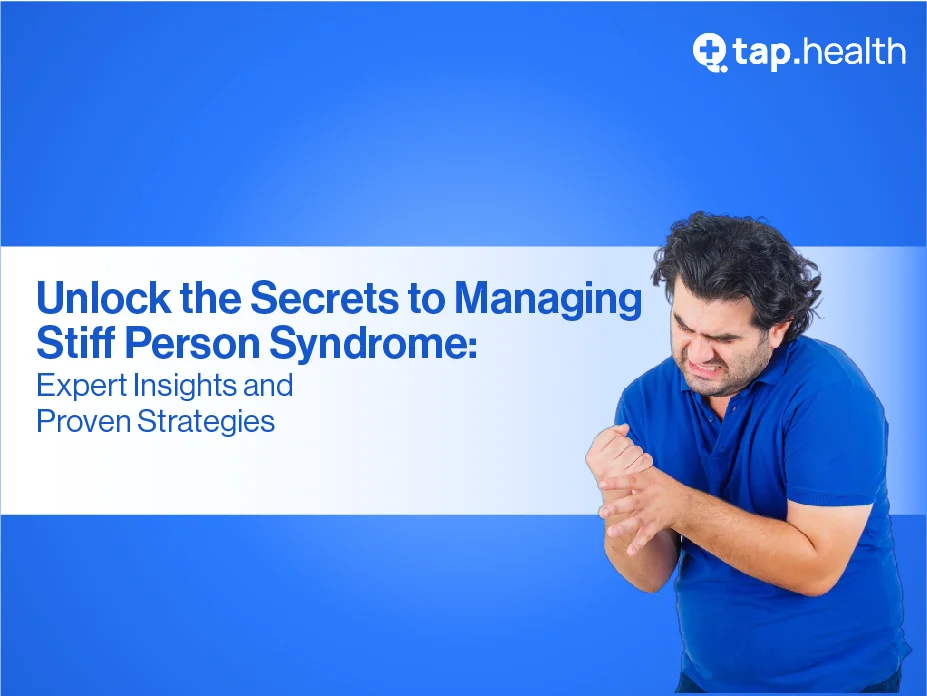Stiff Person Syndrome (SPS) is a rare neurological disorder that impacts muscle function, causing stiffness, spasms, and mobility challenges. This autoimmune condition affects approximately one in a million people, making it difficult to diagnose and manage. In this blog, we address key questions about SPS, including its symptoms, causes, diagnosis, treatment options, and emerging therapies. We also explore support networks and resources to help patients cope with this debilitating condition.
What Is Stiff Person Syndrome?
Stiff Person Syndrome explained: SPS is a rare autoimmune disorder characterized by muscle stiffness, painful spasms, and impaired mobility. It occurs when the immune system mistakenly attacks cells responsible for muscle control, leading to debilitating symptoms. While the exact cause remains unknown, genetic and environmental factors are believed to play a role.
SPS primarily affects middle-aged adults but can occur across all ages, genders, and ethnicities. Its rarity and varied symptoms often lead to delayed diagnosis, which can worsen the condition’s impact on physical and mental well-being. Early recognition is critical for effective management and improved quality of life.
What Are the Symptoms of Stiff Person Syndrome?
Key symptoms of SPS: The hallmark symptoms include:
- Muscle stiffness and rigidity: Often affecting the trunk and limbs, making movement difficult.
- Painful muscle spasms: Triggered by stimuli like noise, stress, or sudden movements.
- Mobility challenges: Difficulty walking, balancing, or performing daily tasks like brushing teeth or tying shoelaces.
- Additional symptoms: Muscle weakness, posture issues, and frequent falls due to impaired coordination.
These symptoms vary in severity, and spasms can occur unpredictably, disrupting daily life. For example, morning stiffness may make getting out of bed a struggle, while sudden spasms can cause painful, jerking movements.
How Is Stiff Person Syndrome Diagnosed?
Diagnosing SPS: Diagnosing Stiff Person Syndrome is challenging due to its similarity to other neurological conditions like Parkinson’s disease or multiple sclerosis. A combination of the following is typically required:
- Medical history review: To identify symptom patterns and triggers.
- Physical examination: To assess muscle stiffness and spasms.
- Specialized tests:
- Electromyography (EMG): Measures muscle electrical activity to detect abnormalities.
- Blood tests: Check for autoantibodies, such as anti-GAD antibodies, commonly associated with SPS.
Consulting a neurologist or movement disorder specialist experienced in SPS is essential for accurate diagnosis. Many patients face misdiagnoses, visiting multiple doctors before receiving clarity, which can be emotionally taxing.
What Causes Stiff Person Syndrome?
Causes of SPS: The precise cause of SPS is not fully understood, but it is primarily linked to an autoimmune response. The immune system attacks glutamic acid decarboxylase (GAD), a protein critical for producing GABA, a neurotransmitter that regulates muscle movement. This disruption leads to muscle stiffness and spasms.
Potential triggers include:
- Genetic predisposition: Certain genetic markers may increase susceptibility.
- Environmental factors: Stress, infections, or trauma may initiate the autoimmune response.
Research continues to explore these factors to better understand SPS and develop targeted treatments.
How Can Stiff Person Syndrome Be Managed?
Managing SPS symptoms: While there is no cure for SPS, several treatment options can help manage symptoms and improve quality of life:
- Medications:
- Muscle relaxants: Baclofen or diazepam to reduce stiffness and spasms.
- Immunomodulatory therapies: Intravenous immunoglobulin (IVIG) or corticosteroids to suppress the autoimmune response.
- Pain management: Medications to alleviate discomfort from spasms.
- Physical therapy: To improve mobility, flexibility, and strength.
- Mental health support: Counseling or therapy to address emotional challenges like anxiety or depression caused by SPS.
Early intervention is crucial to prevent symptom progression and maintain functionality. Patients are encouraged to work closely with healthcare providers to tailor treatment plans to their needs.
What Are the Emerging Therapies for Stiff Person Syndrome?
Promising treatments for SPS: Ongoing research is paving the way for innovative therapies to address SPS:
- Immunomodulatory therapy: Drugs like Rituximab target specific immune system components to reduce autoimmune activity, potentially decreasing muscle stiffness and spasms.
- Gene therapy: Early-stage research aims to correct genetic abnormalities linked to SPS, offering hope for long-term relief by preventing the autoimmune response.
- Neurostimulation techniques:
- Deep brain stimulation (DBS): Involves implanting electrodes to regulate brain areas controlling movement.
- Spinal cord stimulation (SCS): Modulates spinal signals to reduce muscle spasms.
These therapies are still under investigation but show significant potential for improving outcomes for SPS patients.
How Does Stiff Person Syndrome Affect Mental Health?
Emotional impact of SPS: Living with SPS can take a toll on mental well-being due to chronic pain, mobility limitations, and social isolation. Patients often report feelings of frustration, anxiety, or depression. Key strategies to support mental health include:
- Therapy: Cognitive-behavioral therapy (CBT) or counseling to develop coping strategies.
- Support groups: Online communities and advocacy groups provide a platform to connect with others, share experiences, and reduce isolation.
- Mindfulness practices: Meditation or relaxation techniques to manage stress-induced spasms.
Building a strong support system is vital for emotional resilience and overall well-being.
What Support Networks Are Available for SPS Patients?
Resources for SPS patients: Connecting with others who understand the challenges of SPS can be a lifeline. Available resources include:
- Online forums: Platforms like Reddit or dedicated SPS communities allow patients to share stories, tips, and coping strategies.
- Advocacy organizations: Nonprofits like the Stiff Person Syndrome Research Foundation raise awareness, fund research, and provide educational resources.
- Local support groups: Some regions offer in-person or virtual meetups for SPS patients and families.
These networks foster a sense of belonging and provide practical guidance for navigating life with SPS.
Are There Special Considerations for Children with SPS?
SPS in children: While rare, SPS can affect children, presenting unique challenges. Symptoms in children may be mistaken for other conditions, leading to delayed diagnosis. Pediatric SPS management requires:
- Tailored treatments: Adjusted medication dosages and therapies to suit younger patients.
- Family support: Educating caregivers about SPS to ensure proper care and emotional support.
- School accommodations: Working with educators to address mobility or learning challenges.
Early diagnosis and a multidisciplinary approach are critical for improving outcomes in pediatric SPS cases.
What Is the Future Outlook for Stiff Person Syndrome?
Hope for SPS patients: Advances in research offer optimism for better SPS management and potential cures. Continued efforts in:
- Research and clinical trials: Exploring new medications and therapies to target the autoimmune response.
- Global collaboration: Scientists and advocacy groups are working together to accelerate discoveries.
- Patient advocacy: Raising awareness to support funding and research for SPS.
With ongoing dedication, the future holds promise for improved treatments and a better quality of life for those with SPS.
Conclusion
Stiff Person Syndrome is a challenging and rare condition that affects both physical and mental health. While its symptoms—muscle stiffness, spasms, and mobility issues—can be debilitating, early diagnosis, tailored treatments, and robust support networks can significantly improve quality of life. Emerging therapies like immunomodulation, gene therapy, and neurostimulation offer hope for better management and potential cures. By connecting with support groups and staying informed about research advancements, SPS patients and their families can navigate this condition with resilience and optimism.
For more information, explore resources like the Stiff Person Syndrome Research Foundation or consult a neurologist specializing in movement disorders. Together, we can raise awareness and support the pursuit of effective treatments for SPS.



